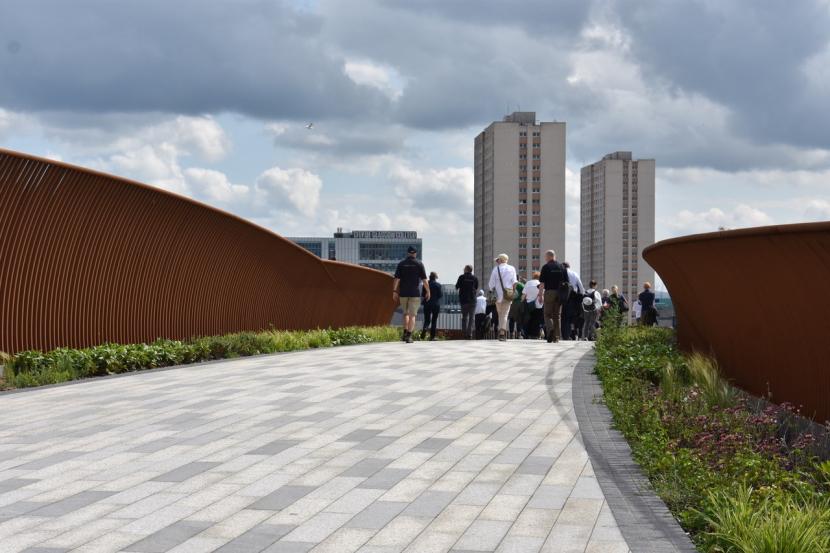Green Infrastructure Project Update - Big can be beautiful

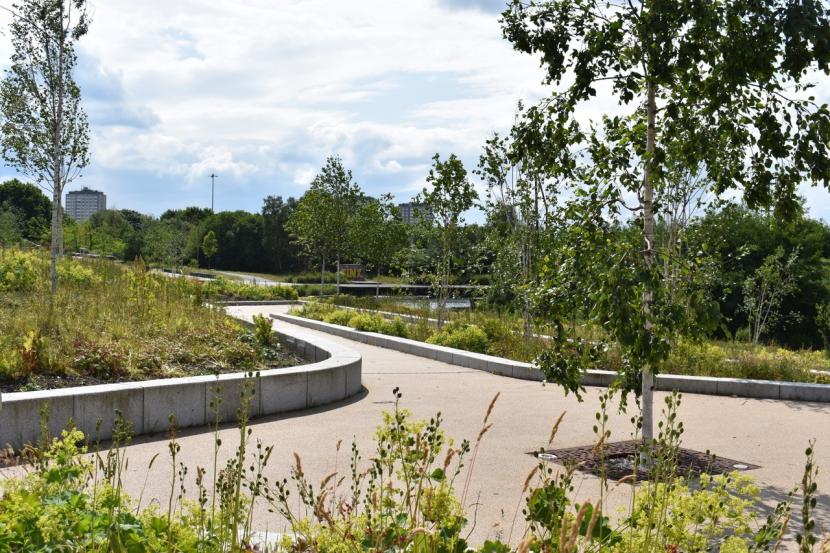
The Green Infrastructure funded Canal & North Gateway project comprises the NGIWMS (Smart Canal), developed by Scottish Canals, Glasgow City Council and Scottish Water, The Claypits Local Nature Reserve, led by Scottish Canals, and the Sighthill blue -green infrastructure led by GCC. The adjacent Hamiltonhill housing project is led by Queens Cross Housing Association.
We looked first at the Smart Canal, James Murray of Glasgow City Council has been involved in many elements of the project. Surface water management is one of his specialist subjects. “Most urban areas, including North Glasgow, have combined sewer systems, this means that surface water from roofs and roads goes into the same pipes as the sewage from toilets and basins. These combined sewer systems were built many years ago. With a changing climate, and increasing development, these combined sewers are quickly at capacity when it rains, which leads to flooding and combined sewer overflows, and means we don’t have capacity for future development and regeneration. We needed to find a way of keeping what is essentially clean surface water out of the combined sewers and slowing it down so our drainage systems have a chance to cope. It is crucial to sustainable development and not increasing flood risk to our existing communities.”
The approach in North Glasgow is remarkable. “The Smart Canal has been developed by Scottish Canals, Glasgow City Council and Scottish Water to enable sustainable development at five key development sites (known as water management areas) by creating a ‘smart’ system that will lower a 19km section of the Forth & Clyde canal by up to 100mm in advance of a heavy storm and discharge that water to the River Kelvin before the peak flow has arrived in the river. This ensures there is the capacity (up to 55,000m3) in the smart canal to receive surface water runoff from the water management areas that are delivering up to 3000 new homes and community facilities over 110 hectares of land. It’s a system that uses live weather forecast data and digital technology to simulate the predicted impact of rainfall, and autonomously control the water level in the canal. This means we can attenuate the flow from these development areas and stops it creating a flood risk in other areas of the city. Of course, it also enables that re-development and regeneration which the city craves to happen. Once the storm has passed, the central server controlling the system will send out signals to re-open canal feeders and close discharge points to return the canal to its normal operating water level and flows”
James highlights that the system isn’t just a technical solution. “Scottish Canals, Glasgow City Council and Scottish Water have managed to provide a system that will save money and save carbon by re-purposing an existing historic asset, the canal, to avoid having to construct new, carbon heavy, infrastructure such as below ground tunnels and stormwater holding tanks” he notes. “By managing water flow we can significant reduce the risk of flooding, and provide a revenue stream that can be used by Scottish Canals to help them maintain and enhance the canal network both for the smart canal and wider community benefit.”
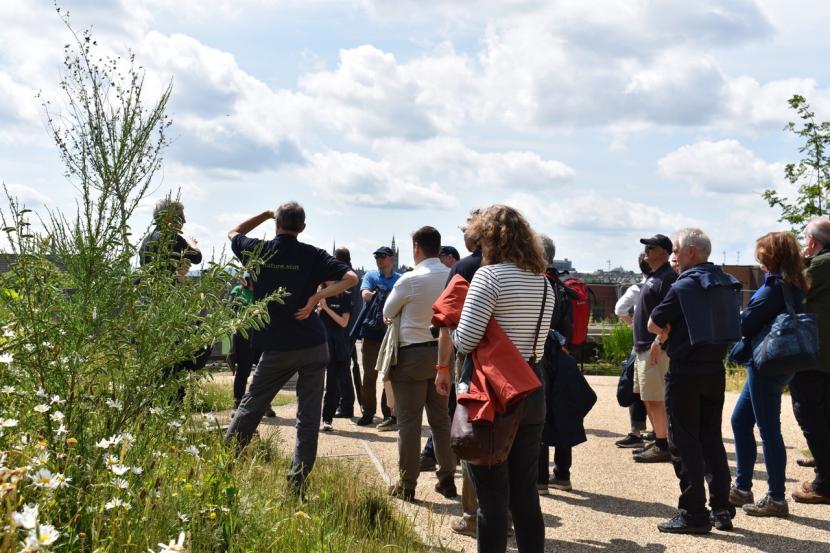
Jill Malvenan agrees that the Smart Canal is a major positive initiative within Scottish Canals, but more importantly for wider environmental and sustainable aspirations. Scottish Canals are now looking at the potential to extend to other locations on the canal network, while the success of the project, including its exposure at COP 26, has led to interest in the scheme from across the world.
Jill led us on a visit to some of the highlights of the Claypits Local Nature Reserve. She is the Design and Development Manager responsible for the Nature Reserve and other associated projects including Garscube Bridge, Garscube Link, Panmure and Applecross improvements including repair of historic structures and creation of new moorings to activate the canal, Infrastructure improvements to support development and address Vacant and Derelict Land, and the SUDs installation facilitated for Queens Cross Housing association to support 600 new homes. These projects, created simultaneously, were managed over eight different packages of work financed through no fewer than 27 different funding sources. The projects as a whole have made a huge difference to the area, the Local Nature Reserve delivering a quality environment to 13,000 households within a 10 minute walking distance of the site, including health, leisure and learning opportunities, and contributing to a diverse environment for nature to thrive.
“My role has been to develop the Claypits Local Nature Reserve, taking the outcome of the initial stakeholder charrette, and delivering the project within the wider overall packages of works funded by SUSTRANS, Glasgow City Council (VDLF), NatureScot (European Regional Development Fund), CSGN, Scottish Canals, Green Exercise Partnership (via Glasgow City HSCP)” explains Jill. “The Green infrastructure funding has contributed to the creation of Glasgow’s only inner-city Local Nature Reserve. Linking neighbourhoods around the canal, it’s now a place rich in wildlife, both common and rare, offering a tranquil space to breathe, enjoy and connect with nature. It’s also a place of important industrial and social heritage, and the project was focused firmly on the many future benefits the Reserve will bring for people, communities and wildlife”
“As the name suggests this area was previously an industrial site, providing clay for the emerging canals, but for many years prior to this current regeneration the area lay derelict and vacant. Dangerous and hard to access it was very poorly used by people, though it did provide a refuge for nature. One of the first things Scottish Canals did as an organisation was remove the 10-foot wall that surrounded our offices and literally open ourselves up to discuss with the community what we could do here, together.”
“All of the design and aspirations for this project have come from ambition generated through community consultations and discussions. The sliding bridge over the canal is an integral part of the project, linking Hamiltonhill and the Nature Reserve to the east of the canal, with the city to the west. The community were integral to the project briefing and now help maintain the space. Not only do they clean and look after the Claypits, but they also organise events often with a focus on nature, visitor numbers to the reserve during 2022 topped the 1 million mark”
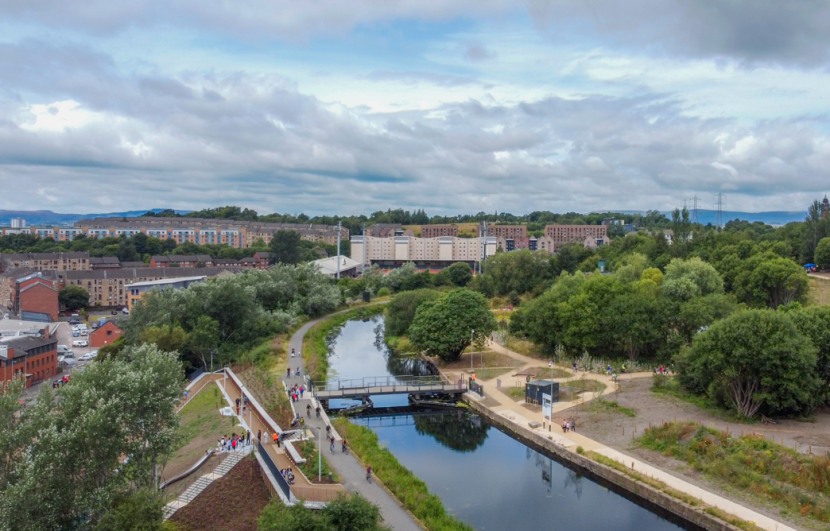
“An especially satisfying aspect of this project has been working with Queen’s Cross Housing Association, to help make possible their plans for proposed housing in Hamiltonhill as one of the key developer sites linked to the Smart Canal. We worked with Scottish Water, seeking to recognise that since 2016 this site has been designated as a nature reserve. The project involved creating a nature reserve compatible SuDS pond on the site, as well as integrating substantial pipework and infrastructure coming down from Hamiltonhill. Working together we have agreed deviations from the standard Scottish Water requirements which allow the infrastructure to sit into the reserve unfenced, and designed including a permanently wet area in the pond to contribute to the ecology of the site. This work has enabled adjacent development in Hamiltonhill which was not previously possible, and the Scottish Canals site includes a further development area of improved viability”
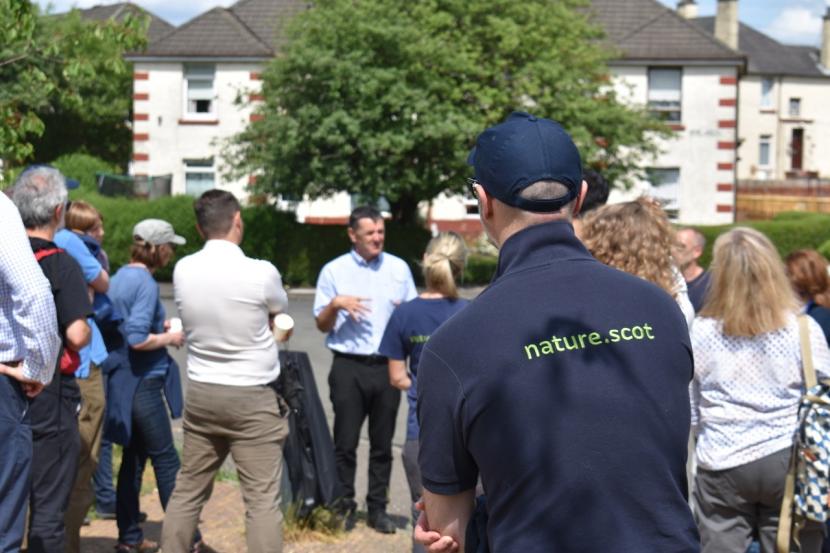
It is hard to imagine a project of this scale without accepting that large sums of money were required. The ERDF grant of £2.38 million was put to good use here and ultimately levered an investment of around £10 million in Nature Based Solutions. Now that the regeneration of Sighthill is in full swing the project encompasses a £250 million regeneration, the biggest such expenditure outside London.
James would echo Jill’s observations about the sympathetic management of water. “At Sighthill the visitor will notice that the kerbs have a pronounced dip in them in certain places. This is to allow the water to run off the road into a rain garden, a SuDS pond or over to our street trees. There are very few traditional road gullies in this huge development. This approach using blue-green infrastructure helps to provide attenuation of surface water to reduce flood risk as well as providing vegetation that has benefits in terms of providing a home for biodiversity, capturing pollutants before they get to the canal, urban cooling and health and wellbeing benefits associated with proximity to greenspace. The developments have also delivered a range of novel SuDS features, such as the ‘street canal’ features, which help the local community engage with water, whilst also helping the area to better manage heavy rainfall.
We may be in the heart of Glasgow but the Monklands Canal is a key part of the system.
“The Monklands Canal,” James says, “links into the Forth and Clyde canal summit pound at Port Dundas. When they built the M8 motorway they buried the canal into two 600cm diameter pipes, but it still exists and still carries water all the way from Coatbridge and discharges here, so it is controlled as part of the smart canal system too. It surprises people to learn that Scottish Canals can close the feeder back up in Coatbridge and put that water elsewhere to maintain the capacity needed here for big storm events. The Smart Canal also closes the feeder at Kilsyth, and discharges at 3 main locations (Ruchill, Shirva and Craigmarloch) along its length”
Like the Claypits, Sighthill has modern practices embedded in its design approach. “There are no fences around the SUDS ponds, nor around our street canal features in Sighthill. That was a cause for concern for some sections of the community, but we believe we should be starting to get more comfortable with having water in our open spaces. The canal, which was built over 100 years ago, doesn’t have a fence, but crucially we are creating new stuff here so we are responsible for the risk of this asset from the off. It’s about communicating our assessment of risk, and listening to people’s concerns. We feel that we have a role to help people in being more comfortable with things like unfenced water features. For Scottish Water, one of our key partners, they have a challenge to understand the management and maintenance of different types of assets and their surrounds. We are all ultimately spending public money to maintain this stuff, so we need to get the right balance of appropriate maintenance and risk. Putting a fence around open bodies of water means there is something additional to maintain, and a fence will not necessarily stop people from taking access and can make it more difficult to try to rescue anyone who does need help. Having a fence implies that there is a significant level of risk, which we don’t think is merited in public open space, and won’t give us the benefits which contribute to a sense of place-making.”
Our walk in the sun pressed on through Sighthill until the heavy murmur of the M8 was clearly audible. Into view came a vision in steel. Decidedly rusty looking steel.
“The Corten Steel bridge at Sighthill is a real statement,” James suggests. “it is perhaps the most visible statement in the area. Officially called the Sighthill Bridge, most folk may know it as the rusty bridge. It replaces an old bridge that was here before but that’s where the similarities end. The previous bridge was small, narrow, uninspiring, and not very accessible for cyclists or people with mobility challenges and in deteriorating condition. What we have now is a bridge that connects Sighthill to the city centre, only a 10 minute walk away. Corten steel is designed to have a ‘weathered’ layer of oxidised steel on the surface that protects the rest of the steel, so you don’t have to keep on painting it, it reduces maintenance. Crucially this bridge is fully accessible so offers an inclusive active travel route in and out of the city.”
Installing this new bridge (which wasn't part of the ERDF grant, but shows that the ongoing commitment to green infrastructure continues) was a major task, requiring the busy M8 motorway to be closed twice, once to lift the old bridge out, and once to lift the new structure into position – both times the team had to use Europe’s biggest crane.
Their old friend, the Monkland’s canal, posed a few issues again. It runs beneath the verge of Scotland’s busiest motorway at precisely this point, and in constructing the abutments on the southern side a section of the pipelines had to be re-routed.
The Claypits Nature Reserve, the Smart Canal and the features at Sighthill make a statement. Individually and collectively they skilfully contribute to the masterplan to unlock large areas of North Glasgow socially and economically. At 56 hectares the Canal and North Gateway project was by far the biggest project in NatureScot’s Green Infrastructure suite – and on the evidence of this trip big can be beautiful.
